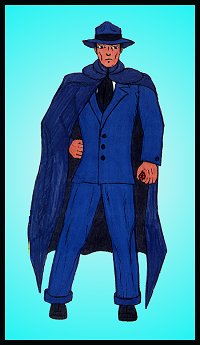Working secretly in his laboratory, Dr. Gade, scientist supreme, is finishing a project that will give mankind work-saving powers and advance civilization one hundred years. But a cowardly assassin breaks into Gade's lab, and in the ensuing struggle Dr. Gade is splashed with chemicals from an overturned vat. Dazed, Dr. Gade is tossed into a blast furnace by the sneaky assassin, who flees the scene as the laboratory burns down. Fortunately for Dr. Gade, the chemicals have made him impervious to flame, and he emerges unharmed. When the good Doctor has cooled down from the fire, he finds himself invisible! Concluding that he has tuned into new vibrations, Dr. Gade feels "full of power" now. Constructing a blue saucer-shaped disk to catch these vibrations, Dr. Gade turns visible again. He makes a miniature version of the disk attached to a belt, allowing him to appear and disappear at will.
Searching for his would-be assassin, Dr. Gade finds him in the den of his employers, the unscrupulous money kings, and promptly throws him out the window 40 stories up! Gade then breaks up the evil money kings’ scheme. One of them, Sorvan, seeks revenge at Gade's laboratory, only to end up de-atomized by one of the doctor’s machines. The Invisible Man only has two further adventures before disappearing forever.
Comments
The Invisible Man materialized only three times in Mystic Comics before fading away entirely. His creators are unknown, but George Harrison did the pencilling for one of his stories.
The Invisible Man is another of Timely’s Gothic heroes, transparently derived from H. G. Wells’ famous novel, which was made into a popular movie. Timely took a character who had been a villain and then a sympathetic but unbalanced man and created a scientist-hero who was accidentally turned invisible by an agent of the money kings. Timely seemed to like using unscrupulous financiers for their villains. In this case, they are trying to stop the good doctor from using his inventions to save humans labor.
Invisibility is a mixed blessing in comics. Floating objects and the like provide for eerie effects, but an invisible hero faces limitations in a visual, action-based medium like comics. The appeal of the character was not just the tie-in to the popular movie, but the great popularity of the Shadow radio program. On the radio, the Shadow could “cloud men’s minds” and become invisible; it worked fine for an auditory medium. Characters like Invisible Justice and Invisible Scarlett O’Neill also banked on the same appeal. But the audio medium of radio was better suited to invisibility as a theme.
Aside from the money kings, the Invisible Man also tangled with a killer named Fatty. According to Jess Nevins, Fatty was based on silent movie actor Roscoe “Fatty” Arbuckle, who was wrongfully accused of murder.
The Invisible Man has never been revived since the Golden Age, but Marvel does have an Invisible Woman.
